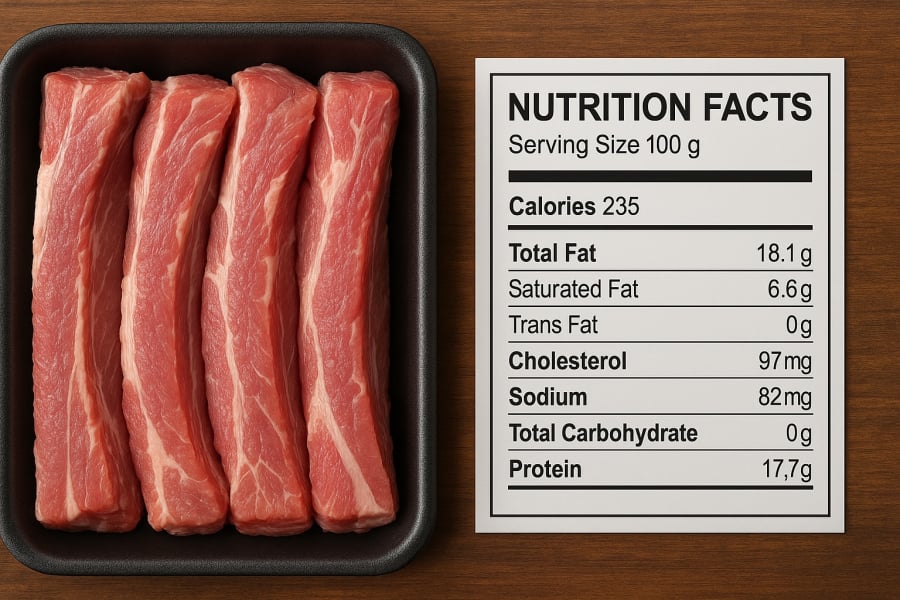Are you a fan of pork ribs, that beloved dish on many a Vietnamese table? Looking at those seemingly lean slices of meat with minimal white fat, you might think this is a healthier choice than fried chicken. But what if I told you that those innocent-looking pork ribs could be “fatter than fried chicken”? The truth sometimes lies beyond our expectations. There are nutritional “secrets” hidden within meats that, if not properly understood, can easily trap even the most health-conscious among us.
Pork Ribs: A Delicious Dish and a Surprising Truth
As a homemaker, I often chose pork ribs, believing them to be leaner and easier to cook into a variety of tasty dishes for my family. Seeing my little daughter enjoy her sweet and sour ribs always brought me peace of mind, thinking I was providing her with a healthy meal. But one day, as I was reading an article about nutrition, I was shocked. The article stated that pork ribs, despite their lean appearance, are a “hidden reservoir of fat” with a significant amount of fat content. This information completely contradicted my perception, like a pinprick bursting a beautiful soap bubble.
Unveiling the “Hidden Reservoir of Fat”: Statistical Evidence Doesn’t Lie
To verify this claim, I decided to investigate the nutritional values of pork. What I discovered left me astonished. Fresh pork ribs contain a whopping 25.3-32.7g of fat per 100g, packing 295-351 kcal. This fat content is four to five times higher than that of lean pork, and the calorie count is double. Compared to fried chicken chunks (17.3g fat, 279 kcal/100g), pork ribs surpass them in both fat and calorie content. Pork ribs, when cooked, don’t appear as greasy as fried chicken, leading many to assume they are healthier. However, the fat in pork ribs can be subtly dispersed within the meat fibers. This underscores the importance of reading nutrition labels and understanding the foods we consume.

Health Benefits of Pork Ribs: Strategies for Smart Consumption
Even though pork ribs are a “hidden fat trap,” they remain a valuable source of nutrition. They are rich in complete proteins, essential for muscle development and cell regeneration. Ribs also contain abundant B-complex vitamins (B6, B12), which support energy metabolism and brain health, along with essential minerals like iron and zinc for a robust immune system. To enjoy ribs without worrying about excess fat, moderation and healthy preparation methods are key. Opt for steamed, boiled, or grilled ribs with minimal marinades instead of deep-frying or stir-frying to reduce fat intake while retaining their nutritional benefits.
Diversifying Your Diet: Exploring Other Cuts of Pork
To ensure a varied and nutritionally balanced diet, don’t rely solely on pork ribs. Pigs offer several other valuable cuts: tenderloin, lean meat (rich in protein, low in fat, and packed with B1 vitamins and iron); pig’s trotters (abundant in collagen and protein, beneficial for joints and skin); and pork offal (rich in protein and iron, low in fat and calories). Eating a diverse range of foods, including vegetables, fruits, and nuts, is key to a well-rounded diet, providing your body with essential micronutrients and preventing diseases. Be adventurous and alternate between different pork cuts to keep your family meals tasty and nutritious.

Final Thoughts from Someone Who Fell into the “Ribs Trap”
After discovering the truth about pork ribs, I altered my habits and adjusted my cooking methods. I still prepare ribs for my family once or twice a week, favoring steaming or boiling, and alternating with pork tenderloin, lean meat, fish, and chicken to maintain balance. Understanding the nutritional aspects of the food we eat is vital for our family’s health, especially for growing children. Don’t let nutritional misconceptions hinder your journey towards a healthier life. Be a wise homemaker, make informed choices, and prepare meals that serve as “nutritional boosters.” I wish you and your family happiness and good health!






































